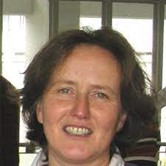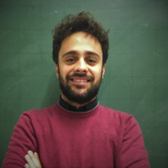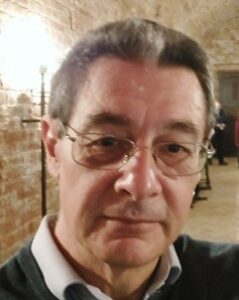Lecturers
 Ross J. Angel
Ross J. Angel
Research Scientist
C.N.R. Instituto di Geoscienze e Georisorse
Padova, Italy
“From lattice dynamics to Equations of State: a simplified approach”
The phonon density of states (pDOS) is responsible for the heat capacity and thermal pressure of solids, but is too complex to introduce into practical equations of state. This lecture will introduce and justify the simplified models for pDOS that can be used in PVT EoS.
 Donato Belmonte
Donato Belmonte
Associate Professor of Geochemistry and Volcanology
Head of the Laboratory of Computational Geochemistry
Department of Earth Sciences, Environment and Life (DISTAV),
University of Genova, Italy
“From lattice dynamics to thermodynamics: a first principles approach”
Micro to macro: from lattice dynamics to thermodynamic properties of crystalline solids. Basic principles of statistical thermodynamics: partition function and phonon density of states. Vibrationally-constrained thermodynamic predictive models: history (Einstein, Debye, Kieffer) and modernity (ab initio).
“From lattice dynamics to thermodynamics: a first principles approach (hands-on tutorial and practicals)”
Computational thermodynamics for phase equilibrium calculations at high pressure and temperature: application to mineral reactions and phase diagrams at planetary interior conditions. Practicals and hands-on
tutorial on Gibbs free energy minimization method by in-house computer codes.

Olivier Beyssac
CNRS senior scientist at IMPMC Paris
(CNRS/Sorbonne Université/MNHN Paris, France)
“Raman Spectroscopy of Carbonaceous Material: RSCM thermometry and more”
Basics of the Raman spectrum of carbonaceous material. How to measure the Raman spectrum of carbonaceous material. RSCM thermometry: how it works, successes and challenges, and some applications. Other applications.
“Spectroscopy on Mars: what’s up on the Red Planet?”
Quick presentation of the NASA Mars2020 mission and Perseverance rover. Scientific instruments and techniques onboard Perseverance: Raman, LIBS, XRF and VISIR reflectance spectroscopy. A focus on time-resolved Raman spectroscopy (SuperCam instrument), and some scientific results obtained by Perseverance.

Tiziana Boffa Ballaran
Senior scientist in charge of the X-ray and Brillouin laboratories
Bayerisches Geoinstitut
Universität Bayreuth, Germany
“Elasticity of minerals in the deep interior of planets as determined by Brillouin scattering measurements”
I will introduce the principles of Brillouin scattering and its role in determining mineral elasticity at high-pressure and high-temperature. Example will be given on how the elasticity of minerals coupled with seismic observations can be used to constrain the composition and mineralogy of planetary interiors.

Nicola Campomenosi
Researcher Associate
Department of Earth sciences, Environment and Life,
University of Genoa, Italy
“Raman spectroscopy applied to host-inclusion systems: a probe for in
situ mineral rheology at non-ambient conditions”
The contrast in the thermoelastic properties between a mineral inclusion and its host leads to residual stresses in the inclusion that change in magnitude and sign as function of different external pressure and temperature conditions. The seminar deals with showing how Raman spectroscopy can be used to quantify residual strain and stress in mineral inclusions at non-ambient conditions and how these data can be used to determine in situ the rheology of minerals undergoing different stress states.

Silvio Ferrero
Associate Professor in Petrology
Chemistry and Earth Sciences Department
University of Cagliari, Italy
“Raman spectroscopy and melt inclusions in metamorphic rocks”
Micrometric melt inclusions in high grade metamorphic rocks tell us the history of the chemical differentiation of the crust through time, and Raman spectroscopy is one of the main tools to rapidly extract reliable information from these tiny objects. We will see examples of how Raman spectroscopy allows us to clarify volatile budgets at depth, find new minerals and new magmatic processes, and understand the origin of peculiar polymorphs of feldspar – the data we need to correctly assess continental subduction and orogenetic processes.

Maria Luce Frezzotti
Professor in Petrology
Department of Earth and Environmental Sciences DISAT,
University of Milano Bicocca, Italy
“Fluid inclusions”

Mattia Gilio
Von Humboldt research fellow
Mineralogisch-Petrographisches Institut
Universität Hamburg, Germany
“Raman elastic geothermobarometry of quartz and zircon inclusions in garnet”
Elastic geothermobarometry allows to interpret the conditions of mineral formation in metamorphic rocks from the difference in physical properties between a mineral inclusion and its surrounding host phase. This seminar deals with the basic theory of Raman-based elastic geothermobarometry and its application on quartz and zircon inclusion in garnet, from the initial measurement to the final P-T estimate.
 Boriana Mihailova
Boriana Mihailova
Professor of Crystallography
Mineralogisch-Petrographisches Institut
Universität Hamburg, Germany
“Basics of Vibrational Spectroscopy”
Atomic dynamics of solids (phonons in crystals and vibrational density of state in glasses). Light-solid interaction processes: Raman scattering vs infrared absorption. The importance of symmetry: selection rules and polarized Raman/infrared spectra.
“Effect of composition on Raman scattering”
One-mode / two-mode behavior. Rock-forming silicates: showcases on nominally anhydrous and hydrous minerals. Alkali silicate glasses.
“Effect of temperature and pressure on Raman scattering”
Temperature and pressure dependence of atomic dynamics: Raman-peak positions, widths and intensities as a function of temperature and pressure. Phase transitions: soft-mode and hard-mode spectroscopy. Showcases of temperature-/pressure-induced phenomena in geomaterials. A note on second-order photon-phonon interactions as well as on resonance Raman scattering and why geoscientists should be aware of such processes.

Mara Murri
Researcher Associate
Department of Earth and Environmental Sciences,
University of Pavia, Italy
“Raman spectroscopy by ab initio calculations”
How to calculate a Raman spectrum by HF/DFT calculations. Comparisons with experimental data. Theoretical experiments and applications in the framework of geological studies.

Fabrizio Nestola
Professor for Mineralogy,
Department of Geosciences
University of Padua, Italy
“Raman Crystal Hunter software: application to mineral inclusions in diamonds ”
Natural diamonds are the only geological materials capable to preserve fragments of very deep Earth from about 120 to even 1000 km depth through its mineral inclusions. The deepest diamonds are named “super-deep diamonds” (also called sublithospheric diamonds) and are the most intriguing and likely most important diamonds to retrieve geological information on the deepest regions of our planet. Micro Raman spectroscopy is likely the most efficient technique in diamond research to investigate such tiny inclusions.

Lutz Nasdala
Professor for Mineralogy and Spectroscopy,
Institute for Mineralogy and Crystallography,
University of Vienna, Austria
“Raman spectroscopy: Better do it right!”
The generally increasing interest in using Raman is in harsh contrast to the existing lack of training opportunities. As a result, a significant fraction of published “results” are tainted with uncertainty. The lecture attempts to summarise potential experimental artefacts and common mistakes, and to give hints on how to do proper analysis.
“Application of Raman and photoluminescence spectroscopy in gemstone Analysis”
Both Raman spectroscopy, and the virtually omnipresent “enemy” laser-induced photoluminescence, have various applications in identifying and characterising gemstones. Examples include gem tourmaline, the historical Schneckenstein topaz, and gems in the Imperial Crown of the Holy Roman Empire.

Alessandro Pisello
Post-doc research fellow
Department of Physics and Geology
University of Perugia, Italy
Web site
“Vibrational spectroscopy as a tool to characterize silicate glasses”
– Silicate glasses theory and occurrence on Earth and terrestrial bodies.
– Disordered structures, short-range order, tetrahedral networks, Q speciation.
– Quantifying Q speciation with vibrational spectroscopy on synthetic glasses (simple compositions)
– Linking spectral features to chemical composition, iron speciation and water content for natural glasses: possibilities and limits.

Mauro Prencipe
Professor for Mineralogy
Earth Sciences Department
University of Turin, Italy
“Symmetry classification of the Raman signals and selection rules”
Vibrational modes can be classified according to the irreducible representations of the point group to which the crystal or the molecule belongs. The symmetry properties of each vibrational mode determine the activity of the mode itself in response to the perturbation caused by the electromagnetic radiation interacting with it. Based on a symmetry analysis it is therefore possible to predict which modes are Raman-active, and under which polarization conditions.

Bruno Reynard
Directeur de Recherches CNRS
Laboratoire de Géologie de Lyon, France
“Raman spectroscopy and mapping: from Earth and planetary sciences to tribology, material sciences, and biology”
Raman spectroscopy and mapping is developed in Earth sciences with the aim of characterizing complex materials potentially submitted to extreme environments. This specificity finds applications in many other fields of science and I show examples of transfer of know-how to various fields based on our work in Lyon.

Natalia Amanda Vergara Sassarini
Postdoctoral Researcher in Planetary Geology at INAF
National Institute for Astrophysics, Italy
We will discuss the role of Raman spectroscopy in assessing the thermal maturity of source rocks. Additionally, we will explore how applying Machine learning on Raman spectra can facilitate maceral recognition, aiding thermal maturity assessment of source rocks characterized by complex organic matter assemblages.